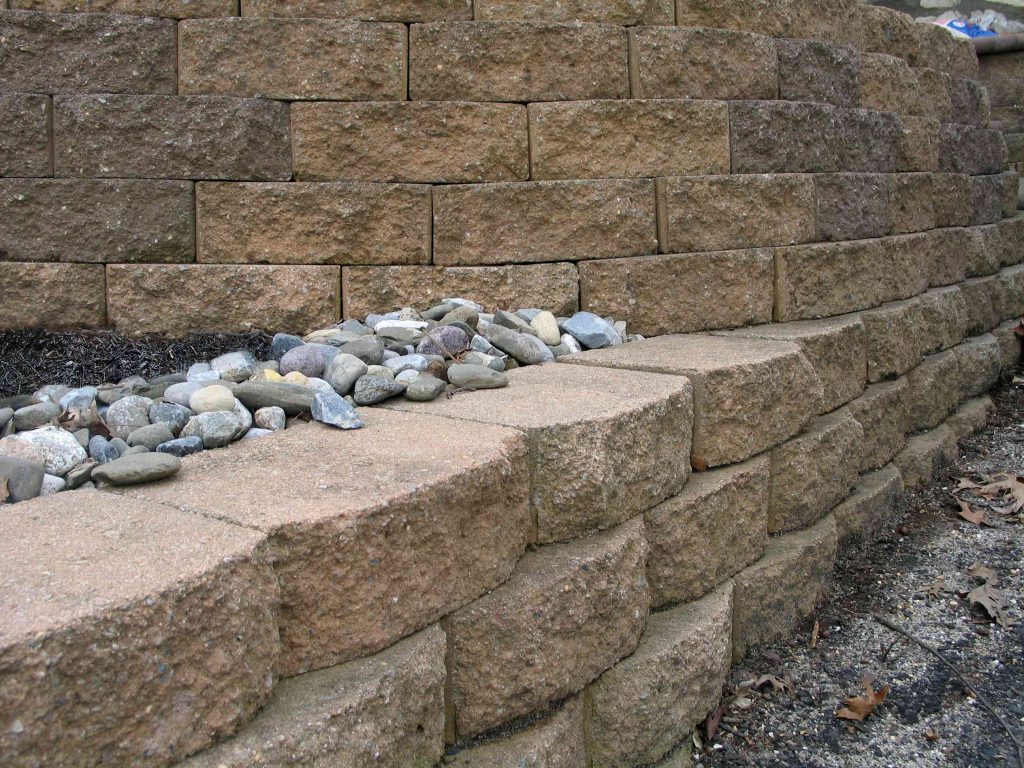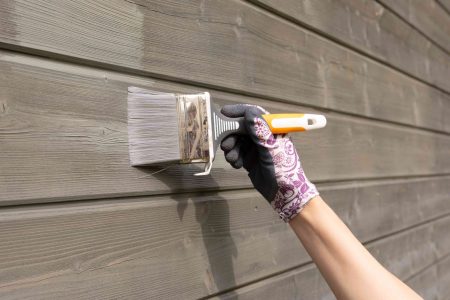Retaining walls hold back immense pressure on slopes. Waterlogged soil, an unstable wall base, or poor backfill can further cause retaining walls to bow, lean, or blow out. Repairing a retaining wall is simple, though labor-intensive. As long as the blocks are in good condition, they can be reused.
When to Repair a Retaining Wall
Repair a retaining wall when the ground is dry and well-drained. If possible, wait until spring or summer to repair the wall.
Permits and Codes
If the retaining wall is above a certain height, a building permit may be required. Depending on your community, the height may range from 3 feet to 5 feet. Always check with your local building and permitting department.
Safety Considerations
Be careful when handling the retaining wall blocks. Larger blocks weigh about 60 pounds, with some blocks as heavy as 80 pounds. Wear eye protection.
What You’ll Need
Equipment / Tools
- Bubble level
- Shovel
- Caulking gun
- Tamping tool
- Wheelbarrow
- Broom
- Shop vacuum
- Sledgehammer
- Eye protection
Materials
- 3/4-inch clear drainage rock
- Fine crushed stone
- Concrete retaining wall blocks (if needed)
- Concrete wall cap stone (if needed)
- Masonry block adhesive
- 6-mil plastic sheeting
Instructions
How to Repair a Retaining Wall
-
Mark the Repair Area
Identify the damaged section of the retaining wall and mark its width on the top of the wall. Step back and look at the wall. The removed block will form a V-shape or inverted pyramid. Adjust the width of the markers so that the “V” will encompass the damage, plus another two blocks on each side.
-
Prepare the Site Below the Wall
Lay plastic sheeting in front of the retaining wall to protect a lawn or sidewalk, as well as to catch debris.
-
Prepare the Block Storage Area
Clear a flat, dry area behind the retaining wall for storing the removed wall blocks.
-
Remove the Cap Blocks
Remove the cap blocks, if any, by knocking them off with a small sledge. Cap blocks are usually adhered to the retaining wall blocks with landscape block adhesive.
-
Remove the Blocks
Remove the retaining wall blocks, starting at the top. Progress down in a V-shape. Remove all blocks down to ground level.
-
Store the Blocks
Store the wall blocks in the storage area behind the wall. Keep the blocks in order.
-
Remove the Backfill
Dig out the backfill material, if any. Clean backfill can be saved and reused.
-
Fix the Cause of the Wall Failure
Fix the condition that caused the retaining wall to fail. If the wall base is unstable, it should be dug out and refilled with gravel and crushed stone. Tree and plant root growth may need to be cut back. Incorrect masonry products like cinderblocks should be replaced with retaining wall blocks.
-
Clean the Remaining Blocks
Clean off the tops of the wall’s remaining blocks with the broom or shop vacuum.
-
Rebuild the Wall Base
If the wall base is inadequate, dig it down to 10 inches. Add 8 inches of drainage stone, followed by 2 inches of crushed stone.
-
Add the Blocks
Rebuild the retaining wall. Level each block from front to back and from side to side. Level each completed course, too.
-
Backfill With Each Course of Blocks
Pour backfill behind the retaining wall after each course of blocks is complete. A 12-inch-width is the required amount of backfill for most retaining walls.
-
Tamp the Backfill
Tamp each new level of backfill with the tamping tool. Tamp lightly to avoid disturbing the wall.
-
Cap the Wall (Optional)
Add retaining wall cap stones to the top course of blocks if needed to match the rest of the wall. Apply several generous beads of landscape block adhesive to the top course of wall blocks. Next, rest the cap stones on top, staggering them over seams.
Tips for Repairing a Retaining Wall
- Keep the retaining wall blocks clean on top and on bottom for a better fit.
- Add 4-inch perforated drain tube to the base of the backfill for improved drainage.
- Replacement retaining wall blocks can be difficult to match, even when the sizes appear to be the same. Take a block with you when shopping for replacements.
- Keep a V-shape or inverted pyramid in mind—not a square or rectangle—when calculating the number of blocks to remove from the wall.
When to Call a Professional
Call a landscaping company to repair retaining walls higher than 4 feet. Make sure that the company has experience with installing and repairing hardscaping materials.
Read the full article here














